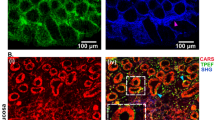Abstract
Background and Aims
The density of epithelial cell extrusion zones in the intestinal lining, also known as gap density (number of gaps/1000 epithelial cells counted), can be quantitated using probe-based confocal laser endomicroscopy (pCLE). Gap density has been reported to be higher than normal in both inflammatory bowel disease (IBD) and irritable bowel syndrome (IBS) patients. Epithelial cells destined for extrusion from the intestinal surface would stain positive for either activated caspase-1 or caspase-3 on mucosal biopsy samples. The aim of this study was to determine whether epithelial gap density on pCLE correlates with quantitative analysis of activated caspase staining of mucosal biopsy samples from patients.
Methods
We obtained pCLE images and biopsy samples of the terminal ileum during colonoscopies of healthy controls and patients with either IBD or IBS. The pCLE images and biopsy samples were blindly analyzed for gap density and for cells staining positive for activated caspases, respectively. The degree of correlation was determined using nonparametric statistical tests.
Results
The median results were 10 gaps/1000 cells counted for controls versus 33 gaps/1000 cells counted for chronic intestinal disorder patients (p = 0.02). Activated caspase staining showed 13 positive cells/1000 epithelial cells counted versus 26 positive cells/1000 epithelial cells counted, respectively (p = 0.02), thus showing a strong correlation with a Spearman’s coefficient ρ of 0.61 (strong correlation for ρ = 0.4–0.75, p = 0.01).
Conclusions
Intestinal epithelial gap density via pCLE correlated strongly with quantitative analysis of immunohistochemical staining of mucosal biopsy samples.






Similar content being viewed by others
References
Kiesslich R, Goetz M, Angus EM, et al. Identification of epithelial gaps in human small and large intestine by confocal endomicroscopy. Gastroenterology. 2007;133:1769–1778.
Liu JJ, Wong K, Thiesen AL, et al. Increased epithelial gaps in the small intestines of patients with inflammatory bowel disease: density matters. Gastrointest Endosc. 2011;73:1174–1180.
Turcotte JF, Kao D, Mah SJ, et al. Breaks in the wall: increased gaps in the intestinal epithelium of irritable bowel syndrome patients identified by confocal laser endomicroscopy (with videos). Gastrointest Endosc. 2013;77:624–630.
Turcotte JF, Wong K, Mah SJ, et al. Increased epithelial gaps in the small intestine are predictive of hospitalization and surgery in patients with inflammatory bowel disease. Clin Transl Gastroenterol. 2012;3:e19.
Karstensen JG, Saftoiu A, Brynskov J, et al. Confocal laser endomicroscopy: a novel method for prediction of relapse in Crohn’s disease. Endoscopy. 2016;48:364–372.
Shavrov A, Kharitonova AY, Claggett B, et al. A pilot study of the predictive value of probe-based confocal laser endomicroscopy for relapse in pediatric inflammatory bowel disease patients. J Pediatr Gastroenterol Nutr. 2015. doi:10.1097/MPG.0000000000001022.
Fritscher-Ravens A, Schuppan D, Ellrichmann M, et al. Confocal endomicroscopy shows food-associated changes in the intestinal mucosa of patients with irritable bowel syndrome. Gastroenterology. 2014;147:1012e4–1020e4.
Liu JJ, Rudzinski JK, Mah SJ, et al. Epithelial gaps in a rodent model of inflammatory bowel disease: a quantitative validation study. Clin Transl Gastroenterol. 2011;2:e3.
Mayhew TM, Myklebust R, Whybrow A, et al. Epithelial integrity, cell death and cell loss in mammalian small intestine. Histol Histopathol. 1999;14:257–267.
Rosenblatt J, Raff MC, Cramer LP. An epithelial cell destined for apoptosis signals its neighbors to extrude it by an actin- and myosin-dependent mechanism. Curr Biol. 2001;11:1847–1857.
Watson AJ, Chu S, Sieck L, et al. Epithelial barrier function in vivo is sustained despite gaps in epithelial layers. Gastroenterology. 2005;129:902–912.
Liu JJ, Davis EM, Wine E, et al. Epithelial cell extrusion leads to breaches in the intestinal epithelium. Inflamm Bowel Dis. 2013;19:912–921.
Kiesslich R, Duckworth CA, Moussata D, et al. Local barrier dysfunction identified by confocal laser endomicroscopy predicts relapse in inflammatory bowel disease. Gut. 2012;61:1146–1153.
Lim LG, Neumann J, Hansen T, et al. Confocal endomicroscopy identifies loss of local barrier function in the duodenum of patients with Crohn’s disease and ulcerative colitis. Inflamm Bowel Dis. 2014;20:892–900.
Gunther C, Martini E, Wittkopf N, et al. Caspase-8 regulates TNF-alpha-induced epithelial necroptosis and terminal ileitis. Nature. 2011;477:335–339.
Acknowledgments
We would like to thank Ms. Stephanie Mah and Mr. Harsh Thaker for their assistance with the experiments. Dr. Julia Liu is a recipient of the Canadian Institutes of Health Research New Investigator Salary award. Funding support for the study was provided by the Canadian Institutes of Health Research/Canadian Association of Gastroenterology (CIHR/CAG GNO 96692), the University of Alberta Hospital Foundation (UHF 2011), and NIH P20 GM103625 (Center for Microbial Pathogenesis and Host Inflammatory Responses at UAMS). Ms. Theresa Kay was a recipient of a University of Alberta Faculty of Medicine and Dentistry summer studentship.
Grant support
Grant support was provided by the Canadian Institute of Health Research New Investigator Salary Award (JJL) Canadian Association of Gastroenterology (CIHR/CAG GNO 96692 JJL), Crohn’s and Colitis Foundation of Canada (JJL), the University of Alberta Hospital Foundation (UHF 2011, JJL), National Institute of Health P20 (GM103625, JJL), Faculty of Medicine and Dentistry summer studentship (TMK), the Canadian Foundation for Innovations (RNF), and Natural Sciences and Engineering Research Council of Canada (RTI).
Author information
Authors and Affiliations
Corresponding author
Ethics declarations
Conflict of interest
There were no conflict of interest for this study.
Rights and permissions
About this article
Cite this article
Liu, J.J., Kay, T.M., Davis, E.M. et al. Epithelial Cell Extrusion Zones Observed on Confocal Laser Endomicroscopy Correlates with Immunohistochemical Staining of Mucosal Biopsy Samples. Dig Dis Sci 61, 1895–1902 (2016). https://doi.org/10.1007/s10620-016-4154-x
Received:
Accepted:
Published:
Issue Date:
DOI: https://doi.org/10.1007/s10620-016-4154-x




